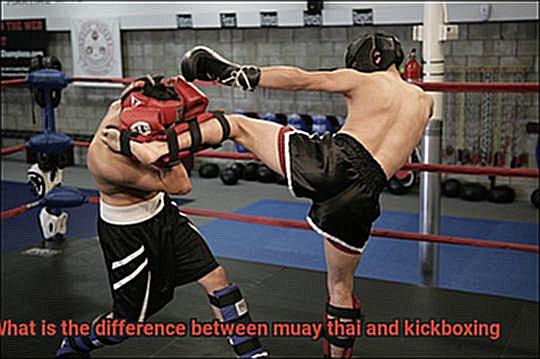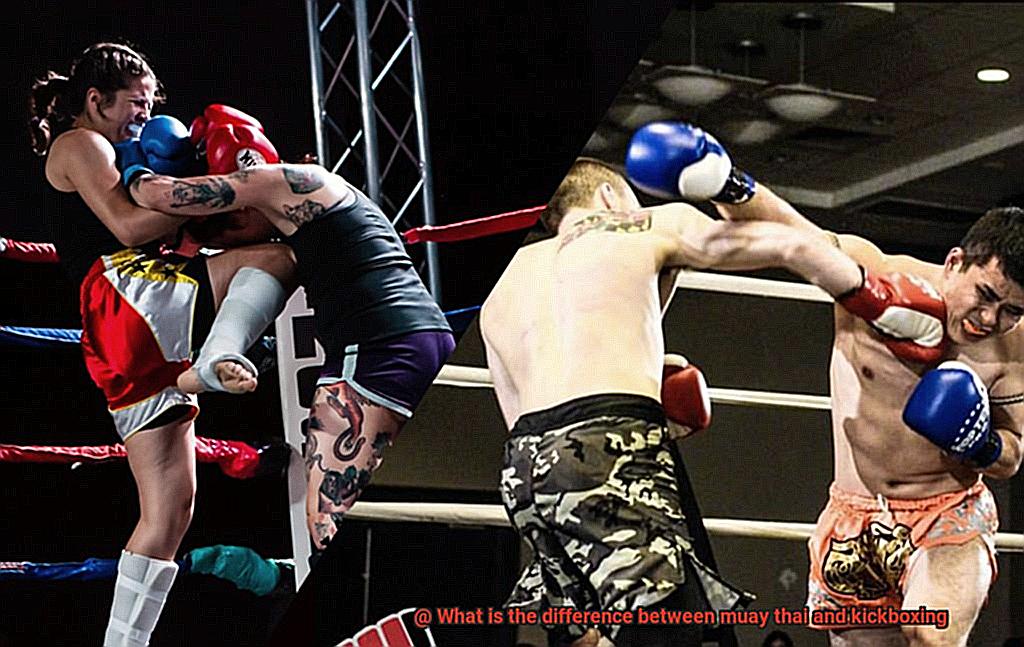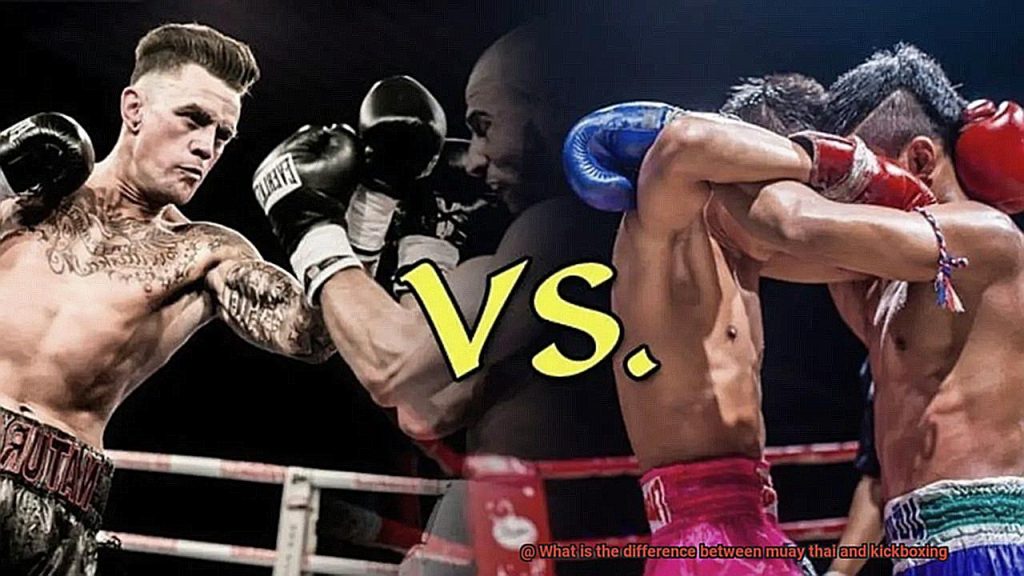Are you a martial arts enthusiast looking to deepen your knowledge about the differences between muay thai and kickboxing? Look no further – we’ve got you covered. While these two combat sports share some similarities, there are key differences that set them apart.
Muay thai, also known as the “Art of Eight Limbs,” was developed in Thailand and is characterized by its use of fists, elbows, knees, and shins. Kickboxing, on the other hand, originated in Japan and the United States and primarily focuses on punches and kicks.
One notable distinction between these two styles is their approach to close-range fighting. Muay thai emphasizes clinching techniques that allow fighters to control their opponents using devastating knee strikes and elbow shots. In contrast, kickboxing rules prohibit clinching, grappling, or throws.
So which one should you choose? It all depends on your personal preferences and goals. If you enjoy up-close combat with a focus on clinching techniques, muay thai might be the right choice for you. On the other hand, if you prefer a more kick-heavy style with a greater emphasis on striking from a distance, kickboxing may be more appealing.
Ultimately, the best way to determine which martial art is right for you is to try both out and see which one resonates with your style and personality. Whether it’s muay thai or kickboxing – both offer an exciting journey into the world of martial arts that will challenge your mind and body alike.
Origins of Muay Thai and Kickboxing
Muay Thai and kickboxing are two martial arts that have captivated audiences and fighters for decades. Despite sharing some similarities, they have unique origins, rules, equipment, cultural significance, and techniques that make them distinct from each other.
Muay Thai, also known as the “art of eight limbs,” originated in Thailand over 2,000 years ago. It was developed as a form of self-defense for the Thai people and was even used in warfare. In contrast, kickboxing has its roots in Japan and was developed in the 1950s as a hybrid martial art that combines elements of karate, boxing, and Muay Thai.
One of the most significant differences between Muay Thai and kickboxing is the techniques used. Muay Thai fighters use their fists, elbows, knees, and shins to strike their opponents, while kickboxers primarily focus on punches and kicks.
This difference in technique also manifests itself in how fighters approach clinching – Muay Thai fighters often engage in clinching to control their opponents and deliver knee strikes or elbow strikes while kickboxers are not allowed to clinch.
Moreover, Muay Thai fights take place in a ring that is smaller than a boxing ring to encourage more intense action. The gloves worn by Muay Thai fighters are also lighter because they emphasize harder strikes using bare fists and shins.

In terms of scoring, judges award points for effective striking, knockdowns, and control in the clinch in Muay Thai fights while points are awarded for clean punches and kicks that land on the opponent’s body or head in kickboxing fights.
The cultural significance of these martial arts is also different. Muay Thai has deep cultural roots in Thailand and is often accompanied by traditional music and dance performances before the fight. On the other hand, kickboxing does not have any cultural significance and is purely a sport.
Differences in Techniques Used
Muay Thai and kickboxing may seem similar, but they have distinct differences in the techniques used. Let’s dive deeper into these martial arts and explore their unique approaches to fighting.
Muay Thai is known for its use of eight limbs, including punches, kicks, elbows, and knees. This makes it a fierce fighting style that can deliver devastating strikes at close range. Muay Thai also incorporates clinching techniques, allowing fighters to control their opponent’s movements and deliver powerful knees to the midsection or head.
Kickboxing, on the other hand, primarily focuses on punches and kicks from a distance. Kickboxers use swift, powerful kicks and quick jabs to keep their opponents at bay. The goal of kickboxing is to outscore the opponent by landing more strikes while avoiding their attacks.
One key difference between these martial arts is their approach to defense. Muay Thai fighters rely heavily on blocking with their shins, which are conditioned through intense training sessions. In contrast, kickboxers use a combination of blocks and footwork to evade attacks and counterattack.
Ultimately, choosing between Muay Thai and kickboxing depends on your fighting style and goals. If you prefer close-range combat and clinching techniques, Muay Thai may be the better option for you.
If you prefer a strategic approach that emphasizes scoring points from a distance, kickboxing may be more suited to your preferences.
Rules of Engagement
When it comes to muay thai and kickboxing, it’s easy to get these two sports mixed up. However, there are fundamental differences in their rules of engagement that set them apart.
In kickboxing, fighters can use punches, kicks, and knee strikes above the waistline. The goal is to strike the opponent with power and speed to score points. However, clinching is not allowed in this sport. This means that fighters cannot hold onto their opponent in a tight grip and deliver strikes or execute throws.

Muay thai, on the other hand, is a more versatile martial art that allows for a wider range of strikes including punches, kicks, elbow strikes, and knee strikes both above and below the waistline. Fighters can also clinch and execute sweeps or throws to take down their opponent. This requires a higher level of skill and technique from practitioners.
Scoring in kickboxing is based solely on clean strikes landed on the opponent’s head or torso. Points are awarded for each successful strike. In contrast, muay thai uses a combination of strikes landed as well as technique and style displayed by the fighters. Judges take into consideration factors such as balance, timing, and variety of techniques used.

It’s important to remember that while both sports involve striking techniques and physical endurance, they have distinct differences that make them unique in their own right.
Choosing your fighting style wisely based on your goals and preferences is crucial. Respect for the rules of engagement is also essential as you embark on your journey towards becoming a skilled martial artist.
Glove Weight Differences
Although they may seem like a small detail, the weight of your gloves can make a significant difference in both your performance and safety. One question that arises frequently is, “Why do muay thai and kickboxing gloves differ in weight?”

The answer is quite simple. Muay thai and kickboxing are two distinct sports with unique techniques and strikes. In muay thai, fighters use elbows and knees much more often than in kickboxing. These high-impact strikes require additional padding and protection for both the fighter delivering the strike and their opponent.
As a result, muay thai gloves tend to be heavier, weighing between 12 and 16 ounces. This added cushioning provides extra protection and reduces the risk of injury.
On the other hand, kickboxing emphasizes punches and kicks. Lighter gloves weighing between 10 and 12 ounces are used to allow for greater speed and mobility while executing these techniques. However, kickboxers still need to wear protective gear such as shin guards to avoid injury.
It’s important to note that glove weight can vary depending on the size and weight of the fighter.
Smaller fighters may prefer lighter gloves to improve their speed and agility, while larger fighters may opt for heavier gloves for added protection.
Scoring System Differences
It’s essential to know the rules and regulations to appreciate these sports fully, so let’s dive into the fascinating details.
First up, let’s take a closer look at kickboxing. The scoring system is relatively straightforward; fighters earn points for landing strikes on their opponent. Kicks and punches are given equal value, and whoever lands the most strikes wins the match. Simple, right?
On the other hand, muay thai has a more complex scoring system that rewards fighters for executing specific techniques with precision and power. The judges award points for elbow strikes, knee strikes, kicks, punches, and sweeps. However, each technique is worth different point values based on its effectiveness. For example, knee or elbow strikes are considered more dominant techniques than punches or kicks and earn higher points.
But wait, there’s more. Fighters in muay thai can also earn extra points for executing techniques while their opponent is off-balance or for performing a technique with full force. This adds an extra layer of complexity to the scoring system, making it essential for fighters to not only master specific techniques but also execute them flawlessly.
Another significant difference between muay thai and kickboxing is the use of the clinch. In muay thai, fighters are allowed to hold their opponents in a clinch for up to five seconds while delivering knee strikes and other techniques to destabilize their opponent. In contrast, kickboxing fighters are separated immediately if they enter into a clinch.
_zqtcF7_3xw” >
Conclusion
In summary, muay thai and kickboxing may have some similarities, but they are two martial arts with unique characteristics. From their origins to their techniques, rules of engagement, glove weight differences, and scoring systems, each has its distinct features.
Muay thai’s use of eight limbs and clinching techniques sets it apart from kickboxing’s focus on punches and kicks from a distance. Muay thai fighters can control their opponents using devastating knee strikes and elbow shots while kickboxing prohibits clinching, grappling or throws.
The size of the ring and the gloves’ weight also differ in both martial arts. Muay thai fights take place in a smaller ring with lighter gloves to emphasize harder strikes using bare fists and shins. Kickboxing gloves are lighter for greater speed and mobility while executing techniques.
Choosing between muay thai or kickboxing is subjective as it depends on personal preferences and goals. If one enjoys up-close combat with a focus on clinching techniques, muay thai might be the right choice. On the other hand, if one prefers a more kick-heavy style with a greater emphasis on striking from a distance, kickboxing may be more appealing.
It is crucial to understand these martial arts’ differences to appreciate them fully. Respect for the rules of engagement is essential as one embarks on their journey towards becoming a skilled martial artist.
Glove weight plays an essential role in choosing equipment for muay thai or kickboxing because it affects performance and safety.






